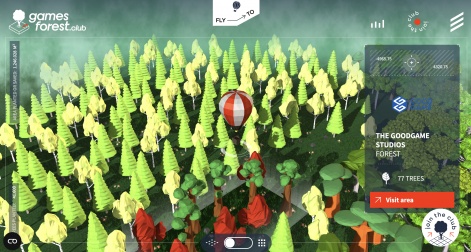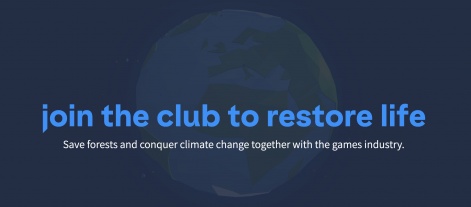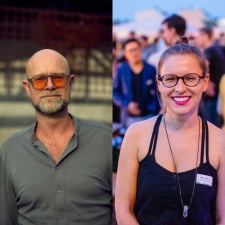Georg Broxtermann cut straight to the point: “The single biggest problem we’re facing on Earth is climate change. But due to every other ongoing crises for the last few years, it’s been pushed out of the discussion.”
Fortunately he and Maria Wagner think they’ve found the solution: “It is a topic with a lot of complexity, and people are fatigued and overwhelmed. What we saw was the need to make it playful and fun, to inspire people to act against climate change.”
Broxtermann and Wagner, co-founders and managers of GamesForest.Club and joint winners of Best Innovation at the 2022 Mobile Games Awards, launched the club in November 2021 following feedback from a wider games industry that wanted to be more proactive in combating climate change.
The project provides a digital twin – an interactive globe which represents the environmental support from games companies as digital forests that players can navigate in a hot air balloon – accessed through the GamesForest.Club website. Numerous games companies, including mobile entities such as Miniclip, an original partner of GamesForest.Club, Goodgame Studios, and Curve have shown their support.

As a forest protection club, Broxtermann remarked that oner of the primary objectives of GamesForest.Club is to provide greater visibility to everyone’s efforts.
Broxtermann stated: “When you’re offsetting your travel impact or planting new trees, it can be easy to lose sight of what you’ve actually done. You don’t know about their condition two or three years later or perhaps can even find the positive impact you’ve made. And the games industry, perhaps more than any other industry, knows that if you cannot measure something, you cannot manage it.”
Wagner also noted how games staff are increasingly environmentally aware, and initiatives like GamesForest.Club can be used to demonstrate their green credentials. “Employees want to see your engagement, and this is an opportunity to do more than just rebrand your company as green but actually demonstrate your actions.”
Playing in the trees
Wagner and Broxtermann are planning to add additional functionality to the forest, as well as correcting some immediate problems based on the growth of the digital forest. Broxtermann said: “Firstly, there will be another viewing perspective: the forest is already too big for the viewing options. We’re envisioning a more pixelated, topdown view.”
Currently, participants are able to contribute 3D assets to their forestry, but Wagner also noted the need to include additional ways of engaging: “We want to include events – embedding riddles within specific areas of the forest for that gaming community to collectively solve, or hidden object gameplay.”
Blockchain gaming is happening regardless. If it has to happen, organisations like ours have to be onboard to encourage a more sustainable wayMaria Wagner
To this end, GameForest.Club is currently working with the SAE Institute, Germany, partnering with students to support their studies of 3D modelling and gamified experiences.
However, the immediate priorities are to increase the number of partners and be able to provide certified carbon credits – a tradable certificate of measurable and verified emissions reductions with a real-world value.
Measuring the metaverse
As the industry and wider global society wrestles with the urgent need to confront climate change, it would be disingenuous not to address how some of the most emergent and disruptive technologies the mobile games industry is persuasing has split the games industry community in two firmly entrenched camps. Namely, blockchain gaming and opportunities from the metaverse.
Broxtermann noted: “The environmental impact is certainly an argument against blockchain gaming. But it’s important to note there are many blockchains running on proof of stake that are not environmentally hazardous – at least, when you compare them with the other hosting platforms and distribution methods.
“There is one clear benefit with blockchain’s decentralised nature: everything becomes transparent. It is very easy to measure the carbon footprint of a game on the blockchain, and if you make your project carbon neutral from the beginning, I can see this becoming an asset for blockchain gaming.”
Broxtermann’s enthusiasm for the metaverse expands to their mission with GamesForest.Club: namely, providing clear, tangible visibility to the problem of climate change and the solution. “I personally have very high hopes for that visibility. Because people struggle to see what CO2 tonnes are, or what global warming looks like.”

Wagner added: “That visibility and measurability is essential. There are too many discussions that don’t factor in figures or comparisons that can bring people along. But it has to be acknowledged that development of blockchain gaming is happening regardless. Our stance is that if it has to happen, organisations like ours have to be onboard to encourage a more sustainable way of moving forward.”
Current support for GamesForest.Club has resulted in 1.2 million square metres of protected forestry and related biodiversity. But, today of all days, I do hope you'll forgive PocketGamer.biz for being perhaps unreasonably direct: do get involved, both with GamesForest.Club and its MGA co-winners Playing for the Planet's Green Game Jam, and any and all other initiatives to combat the enormous threat of climate change.





















